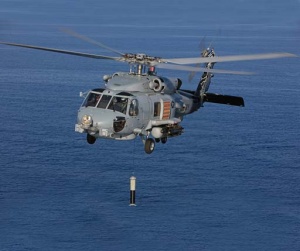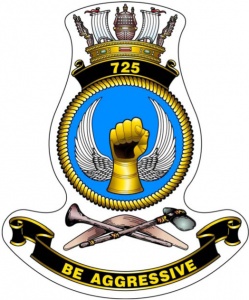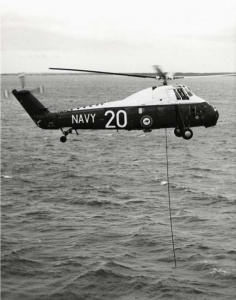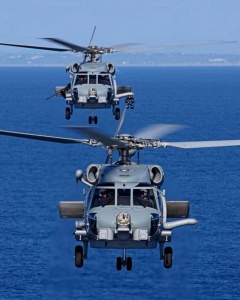725 Squadron Recommissioning
In 2013 the RAN will begin taking delivery of 24 Sikorsky MH-60R Seahawk ‘Romeo’ naval combat helicopters. They will replace the current combat helicopter, the Seahawk S-70B-2 that has been in service since the early 1990s. The Romeo is a proven multi-mission platform already operating with the US Navy and, importantly, will bring a dipping sonar and air-to-surface missile capability back into the Fleet Air Arm (FAA).
MH-60R characteristics
| Endurance ASW | 2.9 hours |
| Endurance ASuW | 3.3 hours |
| Dash speed | 140 knots |
| Maximum takeoff gross weight | 10,659 kg |
| Auxiliary fuel | Up to 2 external tanks |
| Weapons | Air-to-surface missiles, torpedoes, heavy machine guns (HMG) and general purpose machine guns (GPMC) |
| Sensors | Sensors ESM, airborne low frequency sonar, multimission radar, FLIR |
The Romeos will be based at HMAS Albatross, the Naval Air Station (NAS) in Nowra, and will embark for operations in the Anzac Class frigates (FFH), and new Hobart Class destroyers (DDG). They will be equipped with a highly sophisticated and fully integrated combat system designed to employ Hellfire air-to-surface missiles and the Mark 54 anti-submarine torpedo. The first two helicopters will arrive in December 2013.
The Romeos will be operated by 725 Squadron, which is due to recommission in early 2015. The squadron first formed in the RAN more than 50 years ago, and has a history in the Royal Navy stretching back to 27 August 1943. Originally formed as a fleet requirements unit, 725 Squadron’s aircraft and operations varied considerably before moving to Cornwall to become an air target-towing unit in August 1945. The squadron was disbanded in December that year.
The Squadron recommissioned at NAS Nowra as a RAN fleet requirements and communications unit on 13 January 1958. Under the command of Lieutenant Commander John Brown, RAN, the Squadron flew a variety of aircraft including the Douglas C47A Dakota, Auster J5-G Autocar, Hawker Sea Fury Mark IIs, Fairey Firefly AS-5s and Fairey Gannet AS1s. De Havilland Sea Venom FAW Mk 53s were acquired later. In May 1959, the Squadron’s role altered to anti-submarine warfare (ASW) training.
The Squadron suffered its only fatality on 28 December 1959 when Sub Lieutenant Leon Mauritz’s Gannet aircraft crashed while attempting to land at NAS Nowra. The Gannet’s unusual twin engine configuration, driving two counter rotating propellers located one behind the other, enabled the Gannet to fly with only one engine engaged in order to conserve fuel and extend endurance, however, both engines had to be engaged when taking off or landing. Mauritz was attempting a single engine landing with tragic consequences.
Part of 725 Squadron’s responsibilities included providing air interception practice for seamen officers undertaking warfare training at HMAS Watson. The Squadron also assigned air assets to ships working up at sea off nearby Jervis Bay. This role included tasks such as radar and communications calibration exercises through to mock attacks with multiple aircraft. Early in 1958, the squadron’s Sea Venoms also began towing targets for air-to-air live firing practice together with the Sea Furies and Fireflies. The Sea Venoms could tow a target at speeds of up to 250 knots (over 460 kph) whereas the Sea Furies and Fireflies could only manage 140 knots (about 260 kph).
The Squadron decommissioned on 31 May 1961 and was absorbed into 724 Squadron. However, it recommissioned the following year, when the RAN began acquiring its first ASW combat helicopters, the Westland Wessex 31A. Eventually ten Wessex helicopters equipped 725 Squadron, and it used these to deliver ASW training and support to 817 Squadron, the FAA’s front-line Wessex operator.
On 10 February 1964 at 2056 hours, the aircraft carrier HMAS Melbourne collided with the destroyer HMAS Voyager in one of the most tragic accidents in Australian naval history. The disaster resulted in the loss of 82 lives, all from Voyager. 725 Squadron participated in search and rescue efforts in the aftermath of the collision. Later the Squadron embarked in the former aircraft carrier HMAS Sydney throughout the 1960s, providing rotarywing anti-submarine support during her many troop transport voyages to Vietnam, a responsibility it shared with 817 Squadron. In its ASW role, the Wessex was equipped with dipping sonar and an offensive armament of torpedoes and depth charges. In the operational area, the normal routine was to have one Wessex screening the ship, while another was fully armed and prepared on deck. Shortly afterwards, the RAN’s FAA squadrons adopted US Navy prefixes and 725 Squadron became HT725 Squadron indicating that it was classed as a rotary-wing training unit.
The FAA became embroiled in industrial unrest in July 1974 when the Storeman and Packers Union blackbanned the RAN resulting in fuel shortages and flying restrictions. This became an increasingly serious and even life-threatening issue the following month, when heavy rain and flooding inundated the Nowra area. All the FAA’s resources, including 725 Squadron, were called upon for disaster relief operations. The fuel shortage, however, rapidly increased concerns about how long intensive rescue efforts could be continued. Eventually commonsense prevailed and the Union delivered the necessary supplies, allowing personnel from NAS Nowra to rescue some 352 people. On 27 December 1975, 725 Squadron decommissioned following a very successful history of both training and operations.
The recommissioning of 725 Squadron will see the return of a squadron with a proud tradition of training RAN aircrew. The Squadron will thereafter play an important part in implementing the roll out of the new Seahawk Romeo helicopters which will in turn dramatically expand the RAN’s embarked aviation capability.
Sea Power Centre - Australia
Sea Power Centre - Australia
Department of Defence
Canberra ACT 2600
seapower.centre@defence.gov.au






